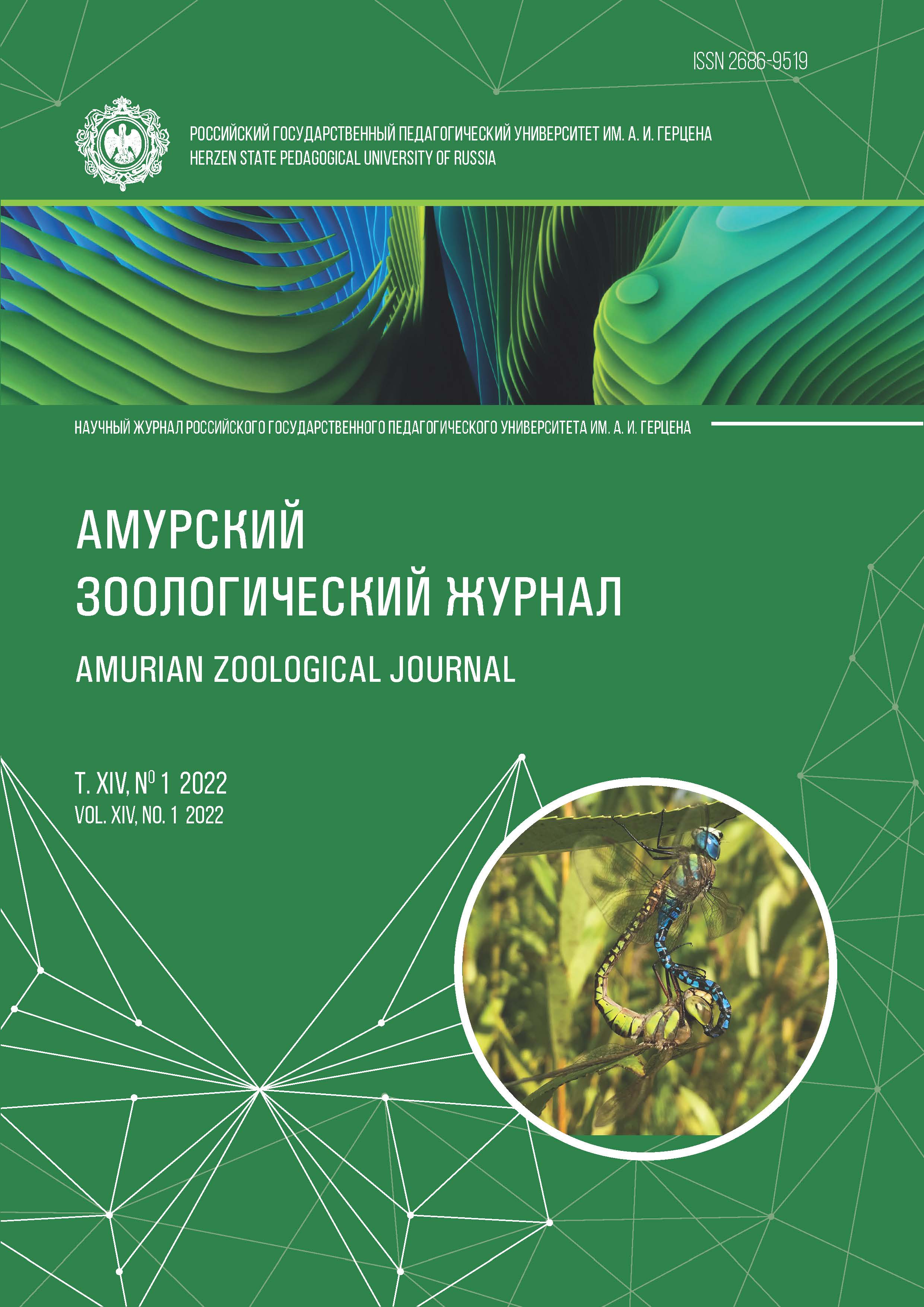Epidemiological and epizoological characteristics of rodent (Mammalia: Rodentia) helminths in Lankaran natural region of Azerbaijan Republic
DOI:
https://doi.org/10.33910/2686-9519-2022-14-1-168-174Keywords:
rodents, helminths, biohelminth, geohelminth, epidemiology, epizoologyAbstract
9 species of rodents belonging to the families Muridae and Cricetidae have been caught in different habitats of Lankaran natural region (dry steppe semi-desert habitats, humid subtropical temperate climate habitats, humid subtropical medium climate habitats, warm broad-leaved forest habitats, mountain forest steppe habitats and mountain steppe habitats) and dissected according to the complete helminthological autopsy method developed by K. I. Skryabin. These rodents are: brown rat Rattus norvegicus, house mouse Mus musculus L., wood mouse Apodemus (sylvaemus) sylvaticus L., grey hamster Cricetulus migratorius, Persian jird Meriones persicus, Tristram’s jird M. blackleri, European water vole Arvicola terrestris L., common vole Microtus arvalis and social vole M. socialis. We found members of 47 helminth species in the dissected rodents, including 7 species of trematodes, 14 species of cestodes, 25 species of nematodes and 1 species of acanthocephalus. Of these, 26 species were biohelminths and 21 species were geohelminths. For these helminth species, we conducted epidemiological and epizootological potential assessment; 10 helminth species were found to be of epidemiological and epizootological significance, because they infect humans and domestic animals. Out of all the trematodes, Gastrodiscoides hominis has epidemiological significance for humans and epizootological significance for domestic pigs, while Echinostoma mijagawai has epizootological significance for domestic waterfowl (ducks and geese). Among the cestodes, adult Taenia hydatigena and Alveococcus multilocularis have epizootological significance for dogs and cats, while their larvae have epidemiological significance for humans and epizootological significance for even-toed ungulates; Hydatigera taeniaeformis has epidemiological significance for humans and epizootological significance for dogs and cats; Taenia pisiformis has epizootological significance for cats; Hymenolepis diminuta has epidemiological significance for humans. One of the nematodes, Hepaticola hepatica, has epidemiological significance for humans and epizootological significance for dogs and cats. Syphacia obvelata has epidemiological significance for humans; one type of acanthocephalus — Moniliformis moniliformis — has epidemiological significance for humans and epizootological significance for dogs and cats.
References
Alibekov, A. M. (2011) Otsenka epidemiologicheskoj situatsii po gel’mintozam v Azerbajdzhane [Estimation of an epidemiological situation on helminthes in Azerbaijan]. Fundamental’nye issledovaniya — Fundamental Research, no. 9–3, pp. 377–381. (In Russian)
Fataliyev, G. G. (2009) Gel’mintofauna gryzunov (Rodentia) Azerbajdzhana i puti ee formirovaniya [Helminthfauna of rodents of Azerbaijan and the ways of its formation]. Yug Rossii: ekologiya, razvitie — The South of Russia: Ecology, Development, no. 4, pp. 118–122. (In Russian)
Fataliyev, G. G. (2009) Azərbaycanda vəhşi məməli heyvanların helmintlərinin epidemioloji, epizootoloji rolu və təbii ocaqlılığı [Epidemiological and epizootiologically role and natural nidus of the wild mammals helminths in Azerbaijan]. ANSA News. Biology Sciences, no. 3–4, p. 64. № 3-4. Baku, Elm., pp. 70-73. (In Azerbaijani)
Fataliyev, G. G., Aslanova, E. K. (2015) Lənkəran təbii vilayətinin duzənlik qurşağında yayılan gəmiricilərinin (Rodentia) helmint faunası [Helminthfauna of rodents (Rodentia) spread in plain areas of Lankaran natural region]. ANSA News. Ganja Department, no. 1 (59), pp. 8–14. (In Azerbaijani)
Fataliyev, G. G., Aslanova, E. K. (2019) Landshaftno-ekologicheskie osobennosti gel’mintov gryzunov gornykh i predgornykh territorij Lenkoranskoj prirodnoj oblasti Azerbajdzhana [Landscape ecological pecularities of rodent helminths of mountainous and foothill territories of Lankaran natural region of Azerbaijan]. Zhurnal Belorusskogo gosudarstvennogo universiteta. Biologiya — Journal of Belarusian State University. Biology, no. 2, pp. 89–94. (In Russian)
Kirillov, A. A., Kirillova, N. V., Chikhlyaev, I. V. (2014) Epidemiologicheskij i epizootologicheskij potentsial gel’mintov pozvonochnykh Srednego Povolz’ya [Epidemiological and epizootiologically potential of vertebrates, helminthes of Medial Povoljye]. Samarskaya Luka: problemy regional’noj i global’noj ekologii, vol. 23, no. 2, pp. 191–200. (In Russian)
Mustafaev, Yu. Sh. (1965) K izucheniyu gel’mintofauny gryzunov Azerbajdzhana [On the study of helminthfauna of rodents in Azerbaijan]. Uchenye zapiski Azerbajdzhanskogo gosudarstvennogo universiteta. Seriya: Biologicheskie nauki, no. 1, pp. 43–47. (In Russian)
Ryzhikov, K. M., Gvozdev, E. B., Tokobaev, M. M. et al. (1978) Opredelitel’ gel’mintov gryzunov fauny SSSR [Definer of helminthes of rodents of USSR fauna]. Vol. 1. Moscow: Nauka Publ., 231 p. (In Russian)
Ryzhikov, K. M., Gvozdev, E. B., Tokobaev, M. M. et al. (1979) Opredelitel’ gel’mintov gryzunov fauny SSSR [Definer of helminthes of rodents of USSR fauna]. Vol. 2. Moscow: Nauka Publ., 278 p. (In Russian)
Sadykhov, I. A. (1981) Gel’minty promyslovykh zverej Azerbajdzhana [Helminths of producers, animals of Azerbaijan]. Baku: Elm Publ., 168 p. (In Russian)
Skryabin, K. I. (1928) Metody polnykh gel’mintologicheskikh vskrytij pozvonochnykh, vklyuchaya cheloveka [Methods of full helminthological autopsy of vertebrates, including humans]. Moscow: Moscow State University Publ., 45 p. (In Russian)
Downloads
Published
Issue
Section
License
Copyright (c) 2022 Elnura K. Aslanova, Gara H. Fataliyev

This work is licensed under a Creative Commons Attribution-NonCommercial 4.0 International License.
The work is provided under the terms of the Public Offer and of Creative Commons public license Creative Commons Attribution 4.0 International (CC BY 4.0).
This license permits an unlimited number of users to copy and redistribute the material in any medium or format, and to remix, transform, and build upon the material for any purpose, including commercial use.
This license retains copyright for the authors but allows others to freely distribute, use, and adapt the work, on the mandatory condition that appropriate credit is given. Users must provide a correct link to the original publication in our journal, cite the authors' names, and indicate if any changes were made.
Copyright remains with the authors. The CC BY 4.0 license does not transfer rights to third parties but rather grants users prior permission for use, provided the attribution condition is met. Any use of the work will be governed by the terms of this license.







